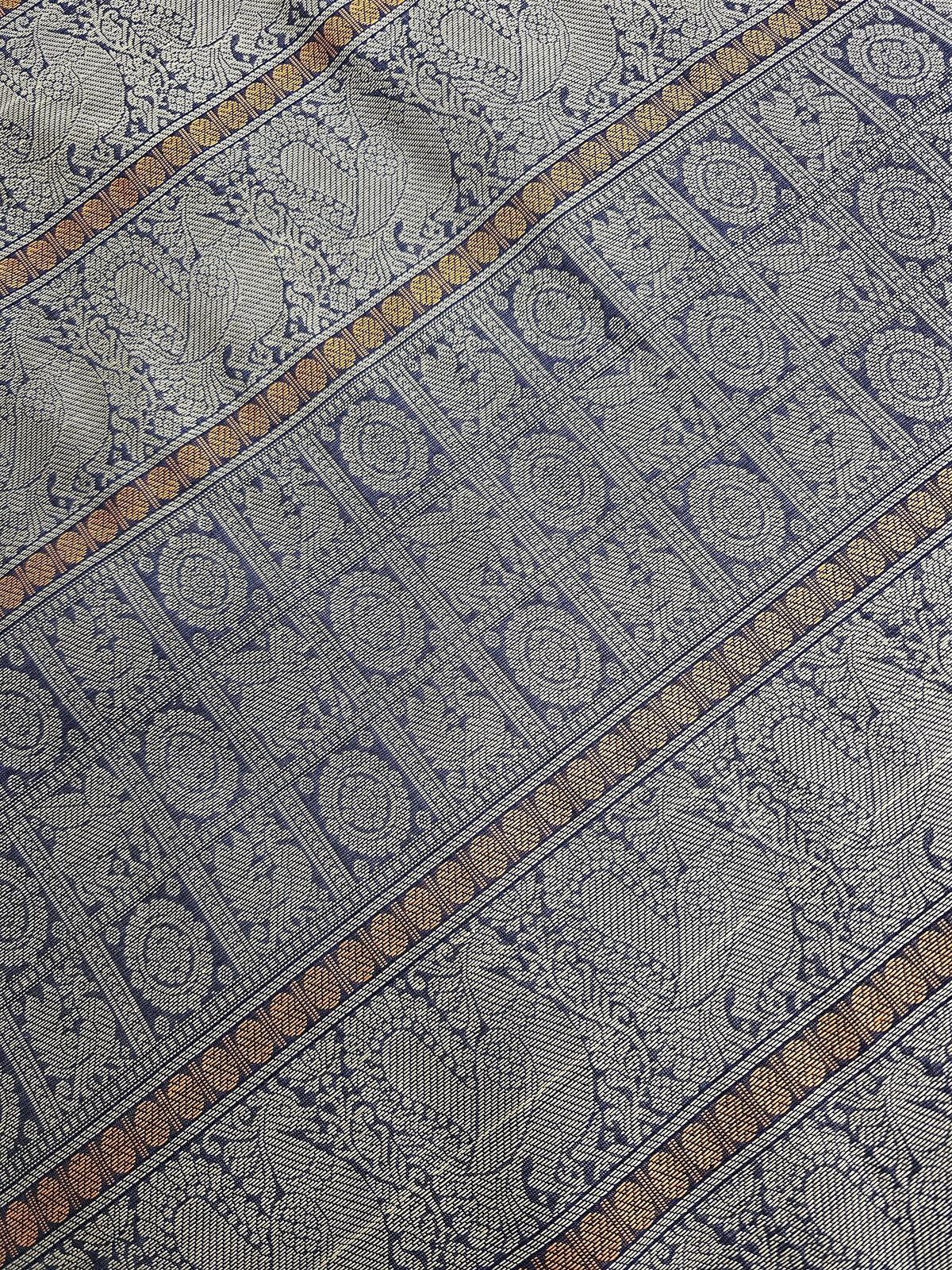Art of Kancheepuram Weave - Learn the story of Sacred and Heritage Motifs

Handloom Kanchi cotton sarees are revered for their exquisite craftsmanship, intricate designs, and deep-rooted cultural significance. Woven by skilled artisans, these sarees feature a variety of motifs, each carrying a unique history and symbolism. These motifs not only enhance the aesthetic appeal of the sarees but also represent traditions, myths, and spiritual beliefs passed down through generations. Below, we explore some of the most significant motifs used in Kanchi cotton saree weaving.
1. Gandabherunda (Two-Headed Eagle)
The Gandabherunda, a legendary two-headed eagle, is a symbol of strength, protection, and divine power. Its origins trace back to Hindu mythology, where it is associated with Lord Vishnu's Narasimha avatar. This motif was prominently used by the Vijayanagara Empire and later became the state emblem of Karnataka. When woven into Kanchi cotton sarees, the Gandabherunda signifies courage, resilience, and royal heritage.
2. Rudraksha (Sacred Beads)
The Rudraksha motif, inspired by the sacred beads associated with Lord Shiva, represents spirituality, protection, and meditation. Rudraksha is believed to ward off negative energies and bring peace to the wearer. This motif is often seen along saree borders, subtly enhancing the traditional and auspicious appeal of the weave.
3. Annapakshi (Divine Swan)
The Annapakshi, a celestial swan, is often depicted in temple sculptures and South Indian art. This mythical bird is believed to have the ability to separate milk from water, symbolizing purity, wisdom, and discernment. Annapakshi motifs woven into Kanchi sarees lend a divine and graceful touch, making them a preferred choice for religious and festive occasions.
4. Mayil (Peacock)
The peacock motif, or Mayil, is one of the most celebrated designs in South Indian textiles. The peacock, associated with Lord Murugan and Goddess Saraswati, represents beauty, elegance, and prosperity. Its vibrant depiction in sarees, often through intricate weaving techniques, makes the drape truly enchanting.
5. Temple Borders and Gopuram Motifs
Kanchipuram is home to many ancient temples, and its saree weaving tradition reflects this influence. Temple borders and gopuram motifs mimic the towering structures of South Indian temples, signifying divinity, tradition, and a connection to sacred heritage. These motifs are often woven along the borders and pallus of sarees, creating a divine aura.
6. Mango Motif
The mango motif, also known as manga in tamil and mamidi pinde in telugu, is an age-old design in Indian textiles, symbolizing fertility, prosperity, and abundance. It is widely used in Kanchi sarees, often interwoven with floral patterns to create a rich and intricate design. This motif adds a timeless elegance to the saree, making it a popular choice for bridal wear.
7. Yaali (Mythical Lion)
The Yaali, a mythical lion-like creature, is often depicted in South Indian temple architecture. It is believed to be a guardian against evil and represents strength and valor. Woven into Kanchi sarees, the Yaali motif adds a majestic and protective symbolism, enhancing the saree’s grandeur.
8. Chakram (Wheel) and Lotus Motifs
The Chakram, representing Lord Vishnu’s divine discus, is a symbol of righteousness and cosmic order. Similarly, the lotus motif represents purity and enlightenment, often associated with Goddess Lakshmi. These motifs are delicately woven into the fabric, reflecting spiritual beliefs and cultural depth.
9. Winged Horse (Devadatta)
The winged horse motif, inspired by mythological depictions of divine steeds, symbolizes speed, strength, and divine energy. Often found in ancient temple sculptures, this motif is woven into sarees to represent movement, power, and grace.
10. Thalampoo Reku (Screw Pine Flower Border)
The Thalampoo Reku motif is designed to resemble the delicate screw pine flower, a significant floral element in South Indian traditions. It adds an elegant and subtle charm to the saree, making it a preferred motif for auspicious occasions.
11. Anklet Design (Kolusu Motif)
The Kolusu motif, inspired by traditional anklets worn by South Indian women, symbolizes femininity, grace, and celebration. This intricate design, often seen along the borders, adds a rhythmic beauty to the saree, reminiscent of the melodious jingling of anklets.
12. Diamond Needle (Kuthu Vala Motif)
The Diamond Needle motif, or Kuthu Vala, signifies precision, craftsmanship, and durability. Resembling the pointed edges of a weaving needle, this motif showcases the skill of artisans and the intricacy involved in the saree-making process.
13. Parrot (Kili Motif)
The parrot motif, or Kili, is a vibrant and auspicious design often found in South Indian sarees. Parrots are associated with love, devotion, and divine wisdom, particularly in connection with Goddess Meenakshi, who is often depicted with a parrot in hand. This motif adds a playful yet traditional charm to Kanchi cotton sarees.
14. Elephant (Yanai Motif)
The elephant motif, or Yanai, symbolizes wisdom, strength, and royalty. Elephants are sacred in Indian culture, often associated with Lord Ganesha and temple processions. Woven into sarees, this motif adds grandeur and an element of auspiciousness, making it ideal for special occasions.
15. Kamadhenu (Divine Cow Motif)
The Kamadhenu motif represents the celestial wish-fulfilling cow from Hindu mythology. Kamadhenu is revered as the mother of all cows and is a symbol of prosperity, nourishment, and divine blessings. This motif, when woven into Kanchi cotton sarees, signifies abundance and grace, making it a cherished design among traditional weaves.
Other Notable Motifs
Apart from the above, several other motifs are occasionally used in Kanchi cotton sarees, such as conch shells (Shankha, representing sacredness and purity), and floral vines (depicting nature and abundance). These motifs add further depth and richness to the saree's storytelling aspect.
Conclusion
Each motif in Handloom Kanchi cotton sarees tells a story of heritage, spirituality, and artistry. Whether inspired by mythology, nature, or temple architecture, these intricate designs make Kanchi sarees not just garments but pieces of living history. Wearing a saree adorned with these motifs is a way of embracing tradition while celebrating the rich craftsmanship of South Indian weavers.